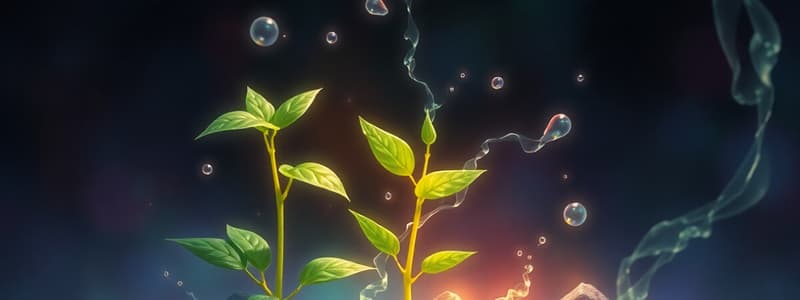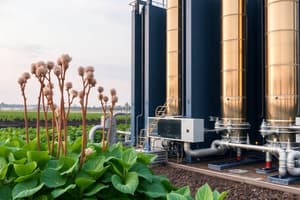Podcast
Questions and Answers
Why is carbon considered the foundation of life as we know it?
Why is carbon considered the foundation of life as we know it?
- It is readily available in the atmosphere.
- It can form a wide variety of complex and stable chemical bonds. (correct)
- It is the primary component of water.
- It is the most abundant element in the universe.
What is the primary limitation on plant growth mentioned?
What is the primary limitation on plant growth mentioned?
- Availability of hydrogen in water.
- Availability of nitrogen in the soil. (correct)
- Availability of carbon in the air.
- Availability of oxygen in the air.
What is the estimated value of the chemicals within a human body at their base elemental level, according to the U.S. Bureau of Chemistry and Soils in 1972?
What is the estimated value of the chemicals within a human body at their base elemental level, according to the U.S. Bureau of Chemistry and Soils in 1972?
- $1,000,000
- Less than a dollar (correct)
- $45,000,000
- $10,000
Why is the value of a human being estimated to be much higher than the sum of its chemical parts?
Why is the value of a human being estimated to be much higher than the sum of its chemical parts?
Which of the following elements is readily available to plants directly from the air?
Which of the following elements is readily available to plants directly from the air?
What process allows plants to obtain carbon?
What process allows plants to obtain carbon?
Air contains a significant amount of nitrogen, why is it not readily available for plants to use directly?
Air contains a significant amount of nitrogen, why is it not readily available for plants to use directly?
Based on the content, what advance significantly increased the amount of food the US could grow?
Based on the content, what advance significantly increased the amount of food the US could grow?
Which type of isomer has the same chemical formula and the same connectivity, yet are nonsuperimposable mirror images?
Which type of isomer has the same chemical formula and the same connectivity, yet are nonsuperimposable mirror images?
A chemist is studying a new drug and discovers that it is chiral. After synthesizing the drug, they find that one enantiomer is effective at treating the disease, while the other causes severe side effects. What is the most important next step for the chemist?
A chemist is studying a new drug and discovers that it is chiral. After synthesizing the drug, they find that one enantiomer is effective at treating the disease, while the other causes severe side effects. What is the most important next step for the chemist?
What kind of interaction is characterized by a weak attraction between two nonpolar molecules that results from transient local dipoles?
What kind of interaction is characterized by a weak attraction between two nonpolar molecules that results from transient local dipoles?
In liquid water, a single water molecule is capable of forming hydrogen bonds with up to how many other water molecules?
In liquid water, a single water molecule is capable of forming hydrogen bonds with up to how many other water molecules?
What force is primarily responsible for maintaining the secondary structure of a protein?
What force is primarily responsible for maintaining the secondary structure of a protein?
A researcher is studying a protein and notices that it tends to aggregate in aqueous solution. Which of the following amino acids would most likely be found in high concentration on the surface of this protein?
A researcher is studying a protein and notices that it tends to aggregate in aqueous solution. Which of the following amino acids would most likely be found in high concentration on the surface of this protein?
Which statement best describes the hydrophobic effect's primary contribution to protein folding?
Which statement best describes the hydrophobic effect's primary contribution to protein folding?
Which of the following is true of structural isomers?
Which of the following is true of structural isomers?
Carbon is uniquely suited to form the basis of life because it can form four covalent bonds. What is another reason carbon is favored over silicon?
Carbon is uniquely suited to form the basis of life because it can form four covalent bonds. What is another reason carbon is favored over silicon?
A researcher is studying a new biomolecule and observes that its function is altered when the molecule's shape is changed without breaking any covalent bonds. What does term best describe this phenomenon?
A researcher is studying a new biomolecule and observes that its function is altered when the molecule's shape is changed without breaking any covalent bonds. What does term best describe this phenomenon?
Why is understanding the structure-function relationship of biomolecules important in the field of medicine?
Why is understanding the structure-function relationship of biomolecules important in the field of medicine?
What is the primary role of functional groups in biomolecules?
What is the primary role of functional groups in biomolecules?
A scientist is investigating a protein and discovers that a specific change in its amino acid sequence (breaking bonds) drastically alters its function. What type of change has occurred?
A scientist is investigating a protein and discovers that a specific change in its amino acid sequence (breaking bonds) drastically alters its function. What type of change has occurred?
Which statement best describes the relationship between the structure and function of biomolecules?
Which statement best describes the relationship between the structure and function of biomolecules?
A chemist is analyzing two molecules with the same chemical formula but different spatial arrangements due to the breaking/formation of covalent bonds. What term describes these molecules?
A chemist is analyzing two molecules with the same chemical formula but different spatial arrangements due to the breaking/formation of covalent bonds. What term describes these molecules?
In drug design, medicinal chemists often focus on mimicking or blocking the interaction of specific functional groups. Why is this a common strategy?
In drug design, medicinal chemists often focus on mimicking or blocking the interaction of specific functional groups. Why is this a common strategy?
Which of the following best describes the relationship between the sequence, structure, and function of a protein?
Which of the following best describes the relationship between the sequence, structure, and function of a protein?
What is a key difference between lipids and the other three major classes of biomolecules (proteins, carbohydrates, and nucleic acids)?
What is a key difference between lipids and the other three major classes of biomolecules (proteins, carbohydrates, and nucleic acids)?
According to the second law of thermodynamics, what is the natural tendency regarding entropy in the universe?
According to the second law of thermodynamics, what is the natural tendency regarding entropy in the universe?
What does Gibbs free energy (G) represent in a closed system?
What does Gibbs free energy (G) represent in a closed system?
Which of the following biological roles is primarily associated with polysaccharides?
Which of the following biological roles is primarily associated with polysaccharides?
Which of the following conditions defines a spontaneous process in terms of Gibbs free energy change ($\Delta G$)?
Which of the following conditions defines a spontaneous process in terms of Gibbs free energy change ($\Delta G$)?
What is the primary function of nucleic acids within a cell?
What is the primary function of nucleic acids within a cell?
What is a defining characteristic of prokaryotic cells compared to eukaryotic cells?
What is a defining characteristic of prokaryotic cells compared to eukaryotic cells?
In a biological system, how can cells drive thermodynamically unfavorable reactions?
In a biological system, how can cells drive thermodynamically unfavorable reactions?
What is the role of ATP in metabolism?
What is the role of ATP in metabolism?
How do the structural properties of lipids relate to their freedom of rotation?
How do the structural properties of lipids relate to their freedom of rotation?
If a reaction has a positive $\Delta H$ and a negative $\Delta S$, what can be said about its spontaneity?
If a reaction has a positive $\Delta H$ and a negative $\Delta S$, what can be said about its spontaneity?
How does the complexity of polysaccharides relate to their biological function?
How does the complexity of polysaccharides relate to their biological function?
Which cellular component is present in prokaryotes?
Which cellular component is present in prokaryotes?
Consider a metabolic pathway where Reaction A has a $\Delta G$ of +15 kJ/mol and Reaction B has a $\Delta G$ of -25 kJ/mol. If these reactions are coupled, what is the overall $\Delta G$ for the coupled reaction, and will the process be spontaneous?
Consider a metabolic pathway where Reaction A has a $\Delta G$ of +15 kJ/mol and Reaction B has a $\Delta G$ of -25 kJ/mol. If these reactions are coupled, what is the overall $\Delta G$ for the coupled reaction, and will the process be spontaneous?
Which of the following is an accurate comparison between catabolic and anabolic reactions?
Which of the following is an accurate comparison between catabolic and anabolic reactions?
What is the primary role of DNA in many organisms?
What is the primary role of DNA in many organisms?
According to Watson and Crick's model, what crucial property of DNA structure facilitates its role in heredity?
According to Watson and Crick's model, what crucial property of DNA structure facilitates its role in heredity?
How does the linear sequence of nucleotides in DNA ultimately determine protein function?
How does the linear sequence of nucleotides in DNA ultimately determine protein function?
Why are random changes in genetic information important for evolution?
Why are random changes in genetic information important for evolution?
What is the significance of Theodosius Dobzhansky's quote, “Nothing in biology makes sense except in the light of evolution”?
What is the significance of Theodosius Dobzhansky's quote, “Nothing in biology makes sense except in the light of evolution”?
The 'Ship of Theseus' paradox relates to biology through what concept?
The 'Ship of Theseus' paradox relates to biology through what concept?
Considering the constant turnover of molecules within a living organism, which statement is most accurate?
Considering the constant turnover of molecules within a living organism, which statement is most accurate?
What is the key implication of the continuous regeneration and replacement of molecules in living organisms?
What is the key implication of the continuous regeneration and replacement of molecules in living organisms?
Flashcards
Carbon's Versatility
Carbon's Versatility
Carbon's ability to form stable bonds with itself and other elements, resulting in diverse molecular structures.
Carbon-Based Building Blocks
Carbon-Based Building Blocks
Amino acids, sugars, and nucleotides are built on carbon frameworks.
Silicon vs. Carbon
Silicon vs. Carbon
Silicon can form four covalent bonds but forms weaker bonds than carbon.
Functional Groups
Functional Groups
Signup and view all the flashcards
Functional Group Role
Functional Group Role
Signup and view all the flashcards
Structure-Function Relationship
Structure-Function Relationship
Signup and view all the flashcards
Conformation
Conformation
Signup and view all the flashcards
Configuration
Configuration
Signup and view all the flashcards
Main elements available to plants
Main elements available to plants
Signup and view all the flashcards
Nitrogen's availability
Nitrogen's availability
Signup and view all the flashcards
Nitrogen from soil
Nitrogen from soil
Signup and view all the flashcards
Nitrogen limits
Nitrogen limits
Signup and view all the flashcards
Haber-Bosch Process
Haber-Bosch Process
Signup and view all the flashcards
Value of Human life
Value of Human life
Signup and view all the flashcards
Carbon
Carbon
Signup and view all the flashcards
Carbon-based Life
Carbon-based Life
Signup and view all the flashcards
Proteins
Proteins
Signup and view all the flashcards
Polysaccharides
Polysaccharides
Signup and view all the flashcards
Nucleic Acids
Nucleic Acids
Signup and view all the flashcards
Lipids
Lipids
Signup and view all the flashcards
Prokaryotes
Prokaryotes
Signup and view all the flashcards
Eukaryotes
Eukaryotes
Signup and view all the flashcards
Nucleoid
Nucleoid
Signup and view all the flashcards
Protein Interaction
Protein Interaction
Signup and view all the flashcards
Second Law of Thermodynamics
Second Law of Thermodynamics
Signup and view all the flashcards
Gibbs Free Energy Equation
Gibbs Free Energy Equation
Signup and view all the flashcards
Non-spontaneous/Endergonic Reaction
Non-spontaneous/Endergonic Reaction
Signup and view all the flashcards
Spontaneous/Exergonic Reaction
Spontaneous/Exergonic Reaction
Signup and view all the flashcards
Equilibrium (DG = 0)
Equilibrium (DG = 0)
Signup and view all the flashcards
Energy Coupling
Energy Coupling
Signup and view all the flashcards
Role of ATP in Metabolism
Role of ATP in Metabolism
Signup and view all the flashcards
Requirements for Genetic Information
Requirements for Genetic Information
Signup and view all the flashcards
DNA's Dual Role
DNA's Dual Role
Signup and view all the flashcards
Basic DNA Unit
Basic DNA Unit
Signup and view all the flashcards
DNA Sequence Significance
DNA Sequence Significance
Signup and view all the flashcards
Gene to Function
Gene to Function
Signup and view all the flashcards
Genotype-Phenotype Link
Genotype-Phenotype Link
Signup and view all the flashcards
Natural Selection
Natural Selection
Signup and view all the flashcards
Evolutionary Adaptation
Evolutionary Adaptation
Signup and view all the flashcards
The Ship of Theseus
The Ship of Theseus
Signup and view all the flashcards
Cis-Trans Isomers
Cis-Trans Isomers
Signup and view all the flashcards
Enantiomers
Enantiomers
Signup and view all the flashcards
Isomers
Isomers
Signup and view all the flashcards
Chiral Center
Chiral Center
Signup and view all the flashcards
Acid-Base Chemistry
Acid-Base Chemistry
Signup and view all the flashcards
Solubility
Solubility
Signup and view all the flashcards
Isoelectric point (pI)
Isoelectric point (pI)
Signup and view all the flashcards
Amphoteric
Amphoteric
Signup and view all the flashcards
Study Notes
- Dr. Scott Napper is a Professor in the Department of Biochemistry at the University of Saskatchewan.
- He is also a Senior Research Scientist at the Vaccine and Infectious Disease Organization-International Vaccine Center.
Biochemistry Definition
- The discipline studies life down to the molecular level.
- It applies chemical philosophies to explain biology.
- The study of the molecular logic of life.
- Underlying common reactions and principles for all living organisms.
Unity of Biochemistry/Life
- Living organisms are remarkably uniform at the molecular level, despite differences size and complexity.
- All organisms use a core of essential biochemical processes.
- All organisms use a common repertoire of building blocks to create biomolecules:
- Nucleic acids
- Proteins
- Polysaccharides
- Lipids
Foundations of Life
- Living state can be considered on the basis of:
- Chemical composition
- Energy
- Genetics
- Evolution
Chemical Foundations
- Living things are made from simple, common ingredients.
- The four elements: carbon, oxygen, hydrogen, and nitrogen account for 98% of most organisms.
- Water accounts for much of the oxygen and hydrogen in living things.
- All known life forms are carbon-based.
- The chemical elements within the biosphere are readily available with:
- Carbon coming from the air through plants (ability of plants).
- Oxygen from the air.
- Hydrogen from water.
- The air contains lots of nitrogen but in an inert form (N2), which is not readily available.
- Nitrogen within the biosphere comes from plants, extracting it from the soil.
- The availability of nitrogen in soil often limits plant growth, therefore impacting food production.
- The amount of naturally occurring nitrogen in soil would enable enough food for about 4 billion people.
- In 1972, the chemicals within a human body had a worth less than a dollar.
- Tissues, organs, and biomolecules within a human being are valued at $45,000,000.
- Chemicals are not exotic but how they come together is priceless.
- Carbon based because it is extremely versatile in terms of the number and variety of chemical bonds that it can form.
- Silicon is the "next-best" candidate as a chemical foundation for life: Silicon can also form four covalent bonds and is abundant in the Earth's crust.
- Carbon-to-carbon bonds are stronger than silicon-to-silicon bonds (more stable biomolecules).
- Combustion of carbon-carbon bonds releases more energy.
- Combustion products of carbon (carbon dioxide) are soluble in the biosphere for recycling.
Molecules and Functional Groups
- Different functional groups are unique with respect to their size, shape, charge, reactivities, and hydrogen-bonding capacity.
- Functional groups determine the structure, function, and properties of the biomolecule.
Biomolecule Structure and Function
- For all biomolecules, structure dictates function.
- Biomolecules "do what they do" because of their structures.
- Understanding the structure allows for prediction of function, including molecular function, and understanding complex biology and development of treatments.
- Conformation is the flexible spatial arrangement of atoms within a molecule (can be changed without breaking covalent bonds).
- Configuration is the fixed spatial arrangement of atoms within a molecule (cannot be changed without breaking covalent bonds).
- Configuration is conferred by either double bonds or chiral centers.
- Geometric (cis-trans) isomers have the same chemical formula:
- They differ in the configuration of groups with respect to a non-rotating double bond.
- Cis: "on this side" groups on the same side of the double bond.
- Trans: "across" groups on opposite sides of the double bond.
- Geometric (cis-trans) isomers can have very different biological properties.
- A chiral carbon has four different substituents attached.
- groups may be arranged in different ways in space yielding two stereoisomers that differ in their configuration.
- Chemical properties of stereoisomers tend to be identical, biological properties can be distinct.
- Biomolecules often constructed exclusively from one stereoisomer.
- Proteins are built entirely from L-Amino acids.
- Interactions between biomolecules are stereospecific.
Complex Molecules
- Biomolecules are often polymers of simple building blocks.
- The structure and function of the resulting biomolecules are more complex than their precursor molecules.
- The whole is greater than the sum of the parts.
- Advantages of constructing biologicals as polymers:
- Simplicity: Simple and conserved reactions for synthesis and degradation.
- Recycling: Biomolecules can be digested back to component building blocks which are reusable.
- Diversity: Complex molecules can be generated.
- There are four major classes of biomolecules:
- Proteins
- Carbohydrates
- Nucleic Acids
- Lipids
- Proteins are linear polymers of amino acids:
- There are 20 amino acids total.
- Amino acids link together to form linear chains that fold into complex patterns with distinct biological activities.
- Polysaccharides are monosaccharides which are
linked together to form linear or branched polymers.
- Higher order polysaccharides have important biological roles relating to structure energy storage, and cellular recognition.
- Nucleic Acids are linear polymers of nucleotide building blocks (5 building blocks for DNA and RNA).
- Acids are involved in all aspects storage and utilization of genetic information.
- Lipids are aggregates (rather than defined polymers) of building blocks. Lipids serve in energy storage, formation of membranes, and signalling.
- There are two basic classes of living organisms; prokaryotes and eukaryotes.
Prokaryotes vs Eukaryotes
- Prokaryotes
- Small (~ 1µm diameter), simple, single cell organisms (such as bacteria).
- Rapid growth allow quick adaptation to changing environmental conditions.
- They have a nucleoid, which contains nucleic acid.
- Eukaryotes
- Large (~100 µm diameter) of complex cells.
- Make up multi-cellular organisms such as yeast, plants, fungi, vertebrates.
- Organelles support specialized functions.
- There is differentiation of cells to unique and specialized cell types.
- Approximately 30 trillion eukaryotic cells are in the human body with another ~100 trillion prokaryotic cells.
- The prokaryotic cells are critical to our health.
- Bacteria in the gut help digest food, help maintain immune system
- Brain in the gut which includes microflora, may effect mental health.
- Possible ways to influence the microbiota include diet, pro and prebiotics, and fecal transplants.
- There are two experimental approaches:
- In vitro studies the behaviour of molecules outside the context of the cell and organism.
- In vivo studies occur within the complexity of the cell or organism.
- Experiments which are successful in vitro often fail in vivo.
- Being alive is energetically expensive, this energy must be obtained from the environment.
Thermodynamics in Biology
- In BMSC230 you will study (in quantitative and chemical terms) the means by which energy is extracted, channeled, and consumed in living cells.
- Cellular energy conversion can be considered in the context of the laws of thermodynamics.
- In any physical or chemical change, the total amount of energy in the universe remains constant, although the forms of the energy may change.
- Living systems and their biomolecules require organization.
- Energy transducing is the conversion of energy of metabolized nutrients, or the energy of the sun converting energy to work:
- Work
- Heat
- Generation of complex biomolecules
Gibbs Free Energy:
- This is from Willard Gibbs is energy changes that comes occur during chemical.
- Free energy (G) of any closed system is defined: energy associated with bonds.
- Enthalpy (H): reflects the number and kinds of bonds.
- Entropy (S): The degree of randomness.
- Temperature: In degrees Kelvin.
- The definition of free energy: G = H - TS
- The free energy change: ΔG = ΔΗ - TΔS
- Non-spontaneous process- Energy input must occur in order to proceed (endergonic).
- Spontaneous processes releases free energy that be used. Exergonic to the point of equilibrium
- System that's in equilibrium- There will be no shift in energy.
- Cells can drive thermodynamically unfavorable reactions by coupling energy requiring (endergonic) to energy releasing (exergonic) reactions. If the sum of the free energy changes is negative, then overall process is exergonic (spontaneous).
- Energy extracts into the adenosine triphosphate(ATP) and serves as a "common" energy currency. ATP has a link between anabolic and catabolic reaction. - Catabolic- the breakdown build: -Anabolic- will the build
Genetic Foundations
- The perpetuation of life requires that genetic information be:
- Stored, expressed & reproduced
- In many organisms, deoxyribonucleic acid (DNA) provides:
- Instructions for cell to form w/ cellular components: Template for product formation with identical molecules that divides a cells. Two complimentary strands and linear polymer of building with a sequence that incodes information.
- DNA has 2 complimentary strands
- Each strand is polymer of 4 different types to its building blocks
- DNA code based on linear sequence that holds all information
- Nucleotide sequence of genes is how amino acid is sequence from being correspond by sequence in DNA
Evolutionary Foundations
- When a organism is mutated in genetic mutation may appear in observable phenotype.
- Survival of the fittest-
- Changes made to hereitary that results in evolution.
Studying That Suits You
Use AI to generate personalized quizzes and flashcards to suit your learning preferences.





